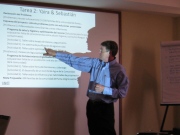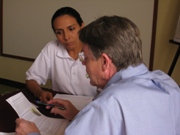In the last newsletter we looked at how researching evidence-based best practices can lead to successful sustainable, impact oriented projects. You can
read that discussion here.
|
How to begin building a set of donor and management tools
|
 |
|
This will only take 30 minutes to do but you will be able to see an immediate change in the organization of your project. It will also make your project more presentable to a donor—and much easier to develop management documents like budgets and schedules.
| The First Donor Presentation |
 |
A few weeks ago I asked you to discuss your project with your coworkers and community members to get ideas and feedback from them. This week I want you to meet someone a bit more challenging with your project. This could be a potential donor, your boss—or your professor if you are a student.
|
This exercise has several valuable benefits: The first is to start thinking in terms of promoting projects to potential donors, and to start thinking about who might be potential donors. Are your donors typically foundations—or online donors? The answer will help you determine presentations for better donor engagement (for example, newsletters for online donors vs. grant proposals for foundations).
The second benefit if you haven’t done this before is to have the opportunity to do it and to experience what a donor appointment is like without putting too much a risk.
The third obvious benefit is to get a different kind of feedback than what you’ve been getting from your co-workers and community members (and me!).
How you can research donors to meet with? Follow the Homework Instructions link above to learn more about the specifics of how to ways to identify donors and approach them with an emerging project. You can also download the complete step-by-step instructions for developing a fast logframe and a finished example of my logframe for a food bank project design.
Please note:
This week’s exercise is part of the process for developing a project design is for a course I teach called OL 201:Designing and Funding Non Profit Projects. The first two assignments in 201 include detailed instructions for conducting a live needs assessment, finding specific resources that you will need for conducting the assessment, an example of a completed assessment, and a project concept based upon the results. The third assignment led you through the process of finding evidence based best practices. This fourth assignment provides simple steps to developing this week’s logframe.
Designing & Funding Nonprofit Programs begins monthly.

I hope that you enjoyed this. If you have a question don’t hesitate to contact us.
Sincerely,
Tim Magee



